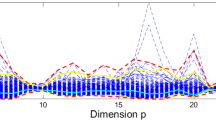Summary
A quasi Bayesian procedure is developed for the detection of outliers. A particular Gaussian distribution with ordered means is assumed as the basic model of the data distribution. By introducing a definition of the likelihood of a model whose parameters are determined by the method of maximum likelihood, the posterior probability of the model is obtained for a particular choice of the prior probability distribution. Numerical examples are given to illustrate the practical utility of the procedure.
Similar content being viewed by others
References
Abraham, B. and Box, G. E. P. (1978). Linear models and spurious observations,Appl. Statist.,27, 131–138.
Akaike, H. (1973). Information theory and an extension of the maximum likelihood principle,2nd Int. Symp. on Information Theory (eds. B. N. Petrov and F. Csaki), Akademiai Kiado, Bdapest, 267–281.
Akaike, H. (1977). On entropy maximization principle,Applications of Statistics (ed. P. R. Krishnaiah), North-Holland, 27–41.
Akaike, H. (1980). On the use of the predictive likelihood of a Gaussian model,Ann. Inst. Statist. Math.,32, A, 311–324.
Barlow, R. E., Bartholomew, D. J., Bremner, J. M. and Brunk, H. D. (1972).Statistical Inference under Order Restrictions, John Wiley and Sons.
Barnett, V. (1978). The study of outliers: Purpose and model,Appl. Statist.,27, 242–250.
Box, G. E. P. and Tiao, G. G. (1968). A Bayesian approach to some outlier problems,Biometrika,55, 119–129.
Freeman, F. R. (1979). On the number of outliers in data from a linear model, Int. Meeting on Bayesian Statistic, May 28–June 2, Valencia, Spain, to be published in a special issue ofTrab. Estadist.
Grubbs, F. E. (1969). Procedures for detecting outlying observations in samples,Technometrics,11, 1–21.
Guttman, I. (1973). Care and handling of univariate or multivariate outliers in detecting spuriosity—A Bayesian approach,Technometrics,15, 723–738.
Guttman, I., Dutter, R. and Freeman, P. R. (1978). Care and handling of univariate outliers in the general linear model to detect spuriosity—A Bayesian approach,Technometrics,20, 187–193.
Hawkins, D. M. (1980).Identification of Outliers, Chapman and Hall.
Kitagawa, G. (1979). On the use of AIC for the detection of outliers,Technometrics,21, 193–199.
Kitagawa, G. (1980). OUTLAP, an outlier analysis program,Computer Science Monographs, No. 15, Institute of Statistical Mathematics, Tokyo.
Tiejen, G. L. and Moore, R. H. (1972). Some Grubbs-type statistics for the detection of several outliers,Technometrics,14, 583–597.
Additional information
The Institute of Statistical Mathematics
About this article
Cite this article
Kitagawa, G., Akaike, H. A quasi Bayesian approach to outlier detection. Ann Inst Stat Math 34, 389–398 (1982). https://doi.org/10.1007/BF02481038
Received:
Revised:
Published:
Issue Date:
DOI: https://doi.org/10.1007/BF02481038




